Meristem Doming and the Transition to Reproductive Development in Tomato
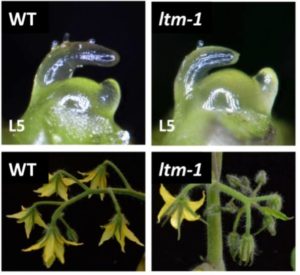 During vegetative growth, the shoot apical meristem (SAM) produces lateral organ primordia but remains roughly the same size, as WUSCHEL–CLAVATA signaling modulates the balance between cell division and differentiation. During the transition to reproductive growth in many species, the SAM expands in size and becomes domed in shape, as if puffing itself up in anticipation of the crucial job of producing flowers (reviewed in Lifschitz et al., 2014). To examine meristem doming and how it relates to the floral transition, Tal et al. (2017) characterized the late termination (ltm) mutant in tomato (Solanum lycopersicum). The ltm mutants flower later than wild type but their meristems dome earlier (figure), indicating that doming has become uncoupled from the floral transition in these mutants. Moreover, the precocious doming in ltm mutants did not involve changes in WUSCHEL or CLAVATA3 expression, nor changes in typical downstream targets of these factors.
During vegetative growth, the shoot apical meristem (SAM) produces lateral organ primordia but remains roughly the same size, as WUSCHEL–CLAVATA signaling modulates the balance between cell division and differentiation. During the transition to reproductive growth in many species, the SAM expands in size and becomes domed in shape, as if puffing itself up in anticipation of the crucial job of producing flowers (reviewed in Lifschitz et al., 2014). To examine meristem doming and how it relates to the floral transition, Tal et al. (2017) characterized the late termination (ltm) mutant in tomato (Solanum lycopersicum). The ltm mutants flower later than wild type but their meristems dome earlier (figure), indicating that doming has become uncoupled from the floral transition in these mutants. Moreover, the precocious doming in ltm mutants did not involve changes in WUSCHEL or CLAVATA3 expression, nor changes in typical downstream targets of these factors.
In addition to examining regulators of meristem size, the authors profiled changes related to floral induction. In tomato, the balance between florigen and anti-florigen affects flowering, meristem termination, and even leaf development. Tomato SINGLE FLOWER TRUSS (SFT), an ortholog of Arabidopsis FLOWERING LOCUS T (FT), and FALSIFLORA (FA), a homolog of LEAFY, promote flowering; SELF PRUNING (SP), a homolog of TERMINAL FLOWER 1, inhibits flowering. Global transcriptome profiling of ltm SAMs showed that a subset of genes activated during floral induction were induced earlier in ltm than in wild type. Intriguingly, SP was precociously activated in ltm mutants and the sp mutation partially suppressed the delayed-flowering phenotype of ltm. Moreover, ltm sp meristems resembled wild type and failed to dome during vegetative phases, but SP-overexpressing meristems domed during vegetative stages, indicating that LTM may act by regulating SP. In contrast to ltm sp, the ltm sft and ltm fa double mutants showed an additive effect on flowering, indicating that LTM acts independently of florigen and FA.
To identify LTM, the authors used genetic mapping, followed by Illumina sequencing of ltm alleles. They found that LTM has five kelch domains, which generally mediate protein-protein interactions, and an EAR motif in the first kelch domain. The authors used yeast two-hybrid assays, bimolecular fluorescence complementation, and site-specific mutagenesis to show that the EAR motif mediates an interaction between LTM and TOPLESS, which functions as a co-repressor. They also identified interactions with transcription factors that may provide specificity for LTM. Based on the conserved domains of LTM, the authors found that the Brassicaceae lack an ortholog of LTM. This shows that tomatoes, with their day-neutral flowering, easily accessible meristems, and balance of florigen and anti-florigens, have plenty to teach us about the regulation of flowering. The remarkable breadth of study organisms remains a major strength of plant biology; extending these studies, within and beyond classical models, will provide better perspective of conserved and specialized processes.
IN BRIEF by Jennifer Mach [email protected]
REFERENCES
Lifschitz, E., Ayre, B.G., and Eshed, Y. (2014). Florigen and anti-florigen – a systemic mechanism for coordinating growth and termination in flowering plants. Frontiers in Plant Science 5, 465.
Tal, L., Friedlander, G., Gilbo, N.C., Unger, T., Gilad, S., and Eshed, Y. (2017) Coordination of Meristem Doming and the Floral Transition by Late Termination, a Kelch Repeat Protein. Plant Cell 10.1105/tpc.17.00030.


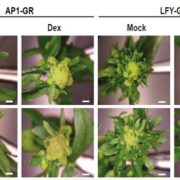
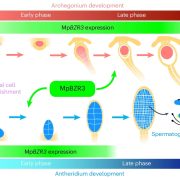
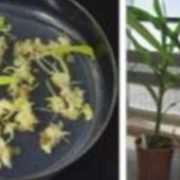
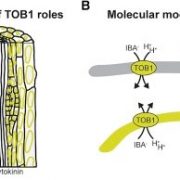
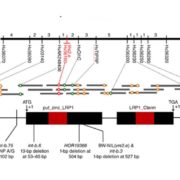
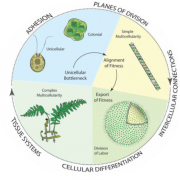


Leave a Reply
Want to join the discussion?Feel free to contribute!